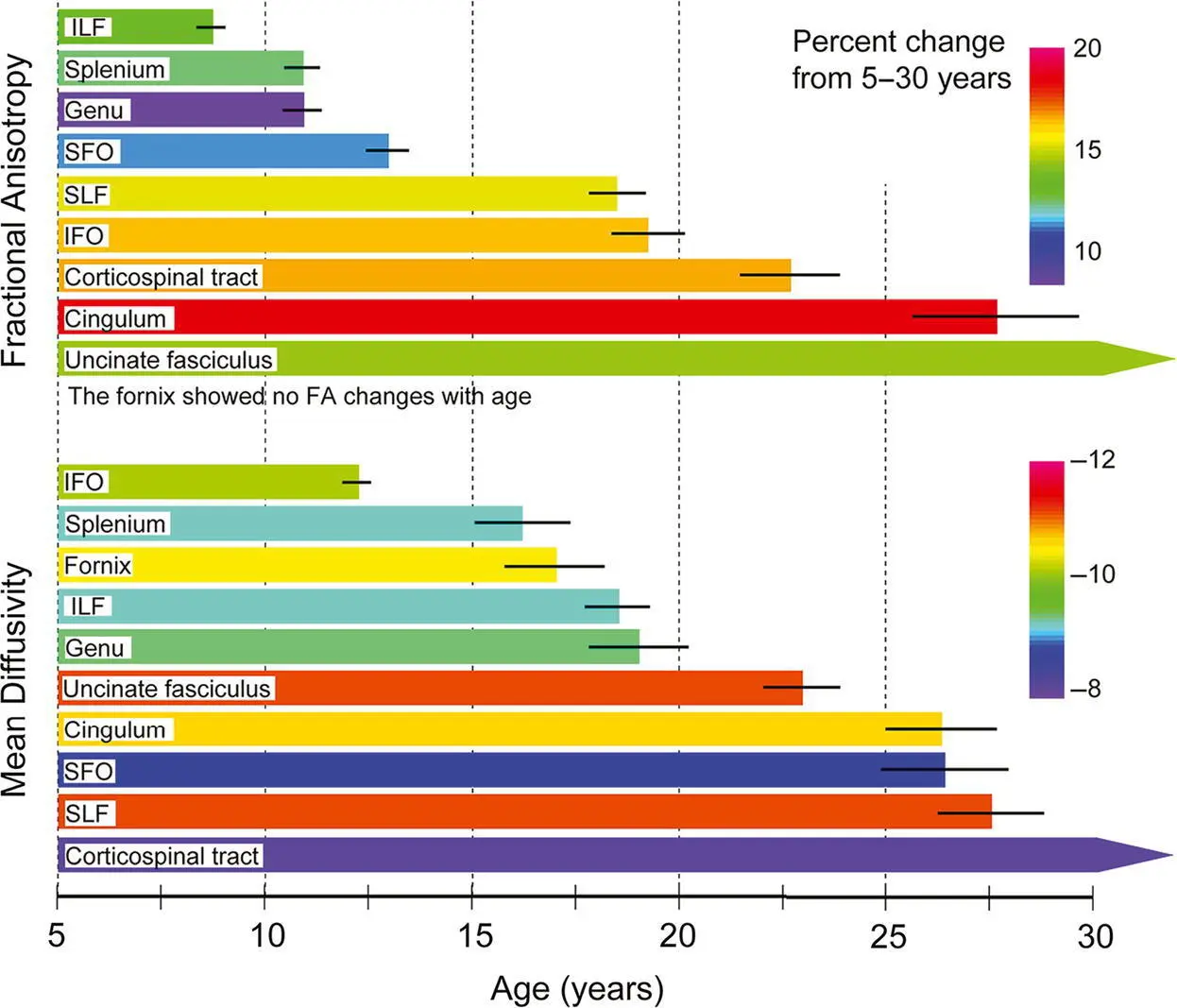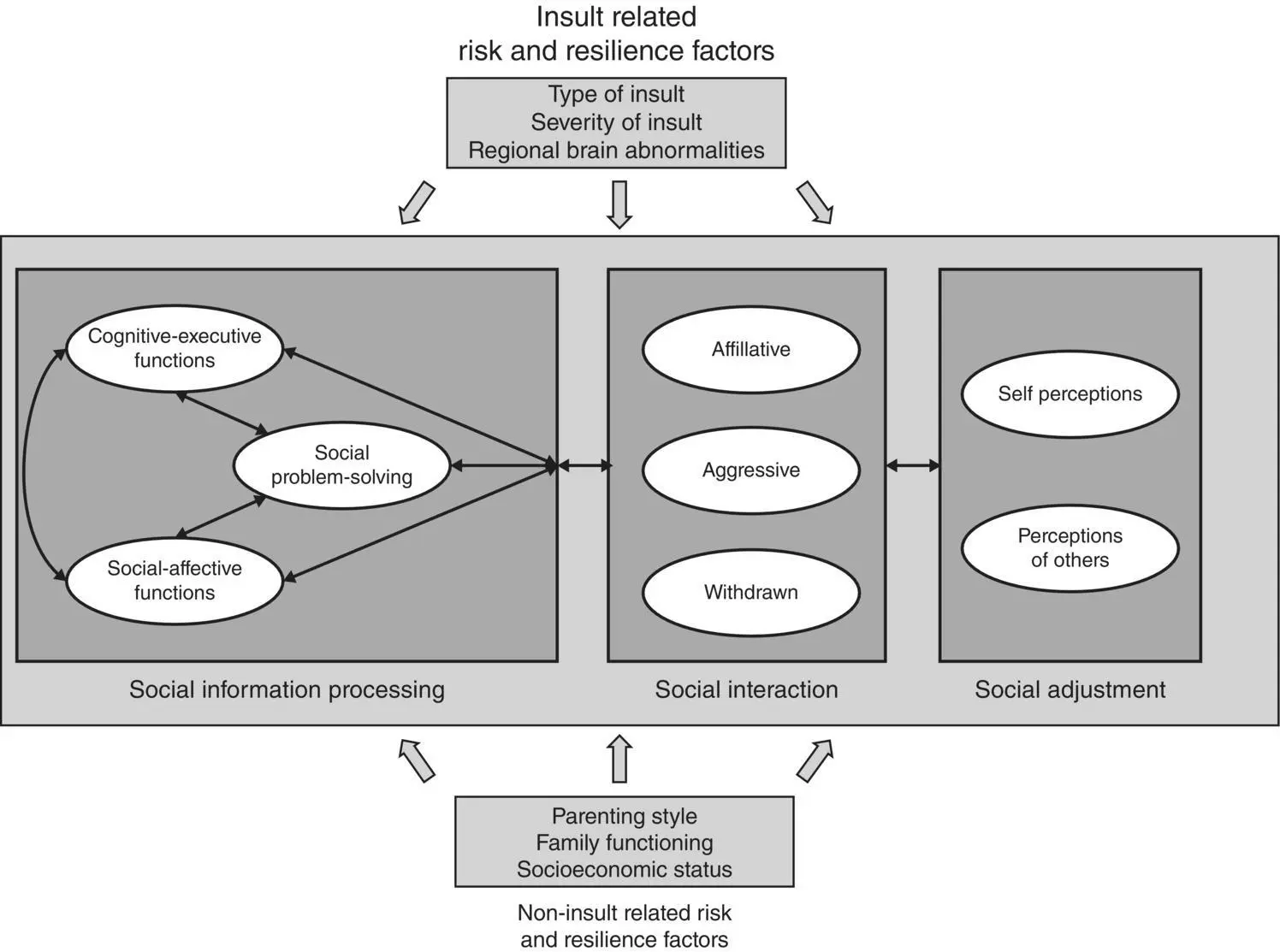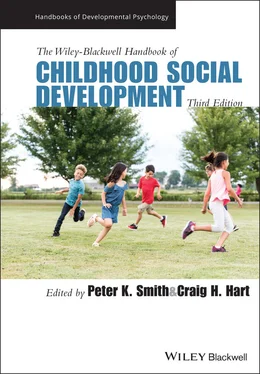All of the networks shown in Table 3.2take years to develop. Cortical regions do not necessarily have the same growth curves as does the whole brain as was shown in Figure 3.3, and maturation curves differ for each lobe and ROI as well (Bigler, 2021). This is shown in Figure 3.8from Somerville. Note in terms of the GM pruning and cortical thickness, that the frontal lobe exhibits the slowest maturation. This also links with neurobehavioral assessments that demonstrate executive control, with social‐emotional functioning and frontal lobe development and their acquisition over childhood and adolescence (Happaney et al., 2004). Furthermore, note that WM stabilization in terms of DTI metrics extends well into the 20s, as shown in Figure 3.8. Accordingly, the neurodevelopmental process is complex as it relates to social brain development, occurs at different rates regionally, all of which means that in the context of social brain development, it extends well into what has been considered early “adulthood.”
This uneven and differential pattern of development mediated by age is also true for subcortical regions of the brain and specific WM tracts, where wide differences are depicted in Figure 3.9(Huang et al., 2015; Mah et al., 2017; Tamnes et al., 2018). Note from Figure 3.9the lengthy maturation process occurring with the cingulum bundle and the uncinate fasciculus, two critical tracts associated with emotional regulation and social brain development.

Figure 3.8 Differences in age when development peaks
(Reproduced with permission from Somerville, 2016). Reproduced with permission from Elsevier.

Figure 3.9 Distinct differences in WM maturation depending on the tract being examined, based on DTI
(Reproduced with permission from Lebel et al., 2019). Reproduced with permission from Wiley.
Adverse Effects, Injury, and Development of the Social Brain
Given what has presented in the figures, charts, graphs, and discussions to this point, if injury or some adverse event occurs at a critical stage of brain development, how does that alter the brain and social behavior? As shown in Figure 3.10, Yeates et al. (2007) proposed a model for the study of acquired pathology that occurred in an otherwise healthy child and how that alteration could influence social brain development as well as the interplay between postinjury social environment and preinjury factors. What is important about this model is that it takes into consideration the multiplicity of preinjury growth and developmental factors as well as the family and social support pre‐ and postinjury along with all of the reciprocal dynamics necessary to execute social behavior. This model has been used extensively in examining social outcome following acquired brain injury in children and adolescents (see Heverly‐Fitt et al., 2016; Ryan et al., 2021) and represents an outgrowth of models discussed by Lemerise and Arsenio (2000) and Rubin et al. (2009).
At this point, TBI has been the most studied, where the age of injury represents an important determiner related to social outcome as shown by Wilde et al. (2021), Lindsey et al. (2019), and Keenan et al. (2018). There are complex family and parenting style influences that interact with the age and type of injury that also influence how a child masters social behavior and which behaviors may remain dysfunctional (Araujo et al., 2017; Root et al., 2016).

Figure 3.10 An integrative, heuristic model of social competence in children with brain disorder
(Reproduced with permission from Yeates et al., 2007). Reproduced with permission from the American Psychological Association.
While these factors has been discussed in terms of the vulnerability of the brain to physical trauma, over the last 20 years considerable attention has been directed to use the advances in network neuroscience, neuroimaging, and brain development, to study the role of adverse childhood experiences (ACE) on the development of the social brain (Bilek et al., 2019; Goetschius et al., 2020; Graziano et al., 2019; Luby et al., 2019; McDermott et al., 2019; Salokangas et al., 2021; Wymbs et al., 2020; Young et al., 2019). A broad spectrum of ACE factors can influence the developing social brain. ACE factors include physical abuse that does not involve trauma to the head as well as all aspects of emotional abuse, including bullying (Lansford et al., 2021). As stated in the opening comments to this chapter, the brain is an experience‐dependent organ, which means that these adverse emotional and stress‐producing experiences likewise shape the developing brain. These changes alter pathway development, growth and pruning patterns as well as overall size of critical brain regions participating in the emergence of the social brain.
Additionally, as also discussed in the introduction, the high nutritional and energy demands on the developing brain further imply that any deficiencies in these areas represent ACE factors as well, with the potential to alter the trajectory of brain development (Dufford et al., 2020; Goyal et al., 2015). This includes poverty and socioeconomic stress as well as access to medical care, all of which influences social brain development (Engel & Gunnar, 2020). Accordingly, there are a host of perceived and/or experienced adverse levels of stress that represent potential hazards for social brain development (Engel & Gunnar, 2020; Juruena et al., 2020).
Contemporary neuroimaging provides a number of methods to study the neural basis of social development. However, because of the newness of these neuroimaging advances, especially related to neural network analyses, research on the neural underpinnings of social development is just emerging. This chapter provides an overview of the field as we begin the second decade of the 21st century.
1 Ackerly, S. (1950). Prefrontal lobes and social development. Yale Journal of Biology and Medicine, 22(6), 471–482.
2 [a] Adolphs, R. (2003). Cognitive neuroscience of human social behaviour. Nature Reviews Neuroscience, 4(3), 165–178.
3 [b] Al‐Ezzi, A., Kamel, N., Faye, I., & Gunaseli, E. (2020). Review of EEG, ERP, and brain connectivity estimators as predictive biomarkers of social anxiety disorder. Frontiers in Psychology, 11, 730.
4 Araujo, G. C., Antonini, T. N., Anderson, V., Vannatta, K. A., Salley, C. G., Bigler, E. D., Taylor, G., Gerhardt, C., Rubin, K., Dennis, M., Lo, W., Mackay, M. T., Gordon, A., Hajek Koterba, C., Gomes, A., Greenham, M., & Yeates, K. O. (2017). Profiles of executive function across children with distinct brain disorders: traumatic brain injury, stroke, and brain tumor. Journal of the International Neuropsychological Society, 23(7), 529–538.
5 Auday, E. S., & Pérez‐Edgar, K. E. (2019). Limbic and prefrontal neural volume modulate social anxiety in children at temperamental risk. Depression & Anxiety, 36(8), 690–700.
6 Bakker, D. J. (1984). The brain as a dependent variable. Journal of Clinical Neuropsychology, 6(1), 1–16.
7 Bassett, D. S., & Bullmore, E. T. (2017). Small‐world brain networks revisited. Neuroscientist, 23(5), 499–516.
Читать дальше















